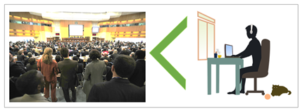Lurking: The Art of Passive Learning in Meetings
The types of annual society meetings are as diverse as there are professional societies worldwide. Some medical, scientific, and academic societies are made up of extremely specialized sub-subfields. While other professional societies cast a wide net, bringing in members from different specialties that share some but not a lot of similarities. And of course, there are some associations that have evolved over the years to provide the best of both worlds, acting like a big umbrella for a very diverse membership, and providing space for the subspecialties to find their own niches within the structure of the whole organization. The American Heart Association is exactly this type of professional partner organization. Medical doctors from numerous specialties belong to the AHA, but so do nurses, and many other healthcare professionals, biomedical scientists, and non-medical researchers and professionals involved in fields that still contribute and promote better cardiovascular health for the public.
As an early-career biomedical researcher, I am involved in a number of these types of professional societies and organizations, each of which provides me with different and valuable experiences and opportunities to expand and develop my career path forward. Within the AHA, I slot into the council on Basic Cardiovascular Sciences (BCVS), one of sixteen different councils that make up the whole association. One of the best attributes of the AHA general structure is the fact that there are specialty annual meetings organized by the different councils (check out my blog about #BCVS20 from a few months back!), as well as a general annual meeting for the whole AHA community (just like the present ongoing #AHA20). This provides someone like myself the chance to network and builds professional connections on multiple levels. It also provides everyone a chance to expand and learn from other fields, bringing in a true sense of multi-disciplinary potential.
This year, unlike any other year before, Scientific Sessions have converted into a fully virtual setting, an appropriate response to the current Covid-19 pandemic. This has promoted all of us to become much savvier (or at least in a constant state of ‘figuring it all out’) with webcam video conferencing, seminar presenting or attending, and online learning. I’m glad that Sessions this year provided an unparalleled On-Demand package, allowing everyone registered to have access extending into early 2021, giving us plenty of time to rewatch or catch up on missed sessions. This is a very welcome outcome for having a virtual meeting, one that is worth taking full advantage of.

Source: Collage from CC-0 images at www.pixabay.com
Another fun new wrinkle I’ve been fully exploiting these past few days has been the use of a very online strategy called Lurking, a term that describes (in this specific context) joining a presentation session, and passively observing the action happening without actively participating in it. What a perfect way to describe and contextualize something that almost all conference attendees have done in-person before. In a #Virtual meeting, one can employ the lurking ‘maneuver’ even more brazenly! Lurking is a perfect strategy to jump into a session midway, or switch quickly from session to session, picking up some new information, and seamlessly moving on to the next item on the schedule, without ever disturbing any other attendees or presenters. I have definitely done a lot of lurking at #AHA20, especially in sessions that are not geared towards my area of expertise in experimental lab biology. Lurking has given me the ability to try out sessions, and learn something completely unrelated to my everyday science. Lurking also gave me the ability to quickly and discreetly bailout of sessions that I couldn’t find my way into, allowing me to pivot into other sessions that better fit my train of thought. Having the chance to attend a highly multi-disciplinary professional meeting, coupled with the ability to sample and view, in a discreet and un-disturbing fashion, many types of presentations is truly a valuable and welcome learning experience.
When possible, I highly encourage the adoption and wide use of online lurking strategies, especially in virtual setting conferences that may be on your calendars in the near future!
“The views, opinions and positions expressed within this blog are those of the author(s) alone and do not represent those of the American Heart Association. The accuracy, completeness and validity of any statements made within this article are not guaranteed. We accept no liability for any errors, omissions or representations. The copyright of this content belongs to the author and any liability with regards to infringement of intellectual property rights remains with them. The Early Career Voice blog is not intended to provide medical advice or treatment. Only your healthcare provider can provide that. The American Heart Association recommends that you consult your healthcare provider regarding your personal health matters. If you think you are having a heart attack, stroke or another emergency, please call 911 immediately.”